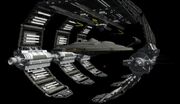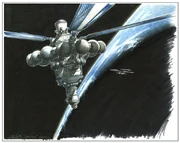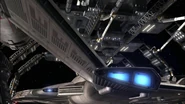AT: "xx" List of spacedocks in orbit of Earth.
Named
- Earth Spacedock
- McKinley Station
- NAR-30974
- Orbital office complex
- Starbase 1 (alternate reality)
Unnamed
Primary Enterprise spacedock
This spacedock was where the first warp five starship, Enterprise NX-01, was constructed.
The spacedock was made up of five cage segments, with one long section providing the dorsal part of the cage and two smaller sections on either side providing the port and starboard parts. These sections housed banks of lights facing inwards, towards where the ship would be located. The dorsal sections also supported a small windowed station in the center of the facility as well as rails that four movable construction arms were attached to. Housed in the center joint of the smaller sections making up the walls of the cage were small stations. Each station had a total of four airlocks at the bow and stern, one facing outwards along the centerline where other segments could be added as well as one airlock each facing port, starboard, and ventral. An airlock was also located on the centerline facing "outwards" from each station. One of the segments on the port side also had a large antennae farm located just below the station. (ENT: "Broken Bow", "The Expanse", "Borderland")
Enterprise was launched from this facility early on a mission to the Klingon homeworld in 2151. (ENT: "Broken Bow")
In 2153, Enterprise was retrofited in this spacedock to upgrade her for the mission to find the Xindi and stop a second weapon from being launched against Earth. (ENT: "The Expanse")
In May 2154, Enterprise departed from this spacedock shortly before investigating the Augment Crisis. (ENT: "Borderland")
Columbia spacedock
This spacedock was the location for the construction of Columbia NX-02, the second Template:ShipClass starship, in 2153 and 2154.
The spacedock was made up of three cage segments that were wider than the segments that made up the spacedock where Enterprise NX-01 was launched from. Instead of having four circular lights in each row on the cage segments, this station had eight rectangular lights that were grouped more closely together. The dorsal sections of the cage supported a small windowed station in the center of the facility as well as rails that three movable construction arms attached to. Housed in the center joint on either side of the sections that made up the walls of the cage were small stations. Each station supported a large cargo bay facing inwards and had one airlock on the bow and stern of the station along the centerline where other segments could be added. (ENT: "The Expanse", "Home", "Affliction")
Columbia was launched from this spacedock in late November of 2154. (ENT: "Affliction")
Secondary Enterprise spacedock
This spacedock was operational for at least some of the time that Columbia was in drydock and was of the same configuration as that facility. After returning from the Xindi mission, Enterprise underwent repair work in this spacedock before moving to the ship's original dock before or in May of 2154. (ENT: "Home")
USS Enterprise spacedock
This dry dock was where the USS Enterprise underwent a refit in the early 2270s, at which time the dock was supervised by both a dock control and yard command. (Star Trek: The Motion Picture) There were at least two cargo or shuttlebays located at the bow end of the dorsal section of the station, as well as several large working lights at various points along the sides of the "cage" facing inwards. (Star Trek: The Motion Picture; Star Trek II: The Wrath of Khan) In 2285, the Enterprise again launched from this dock on a training cruise shortly before the Battle of the Mutara Nebula. (Star Trek II: The Wrath of Khan)
USS Enterprise-E spacedock
This spacedock was where the USS Enterprise-E was repaired in 2379, following the Battle in the Bassen Rift. A small station was located in the center of the dorsal section of the spacedock, and was able to connect to the shuttlebay in the primary hull of a Template:ShipClass starship. (Star Trek Nemesis)
Appendices
Background information

A basic CGI render of the Columbia spacedock
Doug Drexler was not entirely happy with the Earth drydocks of Star Trek: Enterprise. "While I thought the drydocks were well done," he clarified, "I would have made them part of a larger yard encompassing a space office\transportation and residence hub, a supply yard-warehouse complex, and more local traffic. It all boiled down to the limits of a television schedule, and budget." Drexler also personally preferred Star Trek: Enterprise's three-fingered spacedock variant more than the series' five-fingered version. He opined, "The more modest three finger arrangement is more in keeping with the shows time frame, and smaller less sophisticated starship." [1]
Enterprise spacedock info
The docking facility Enterprise launches from in "Broken Bow" may be part of the Warp Five Complex, but this was never confirmed. The facility was referred to as a "Spacedock" in the episode's script. [2] In a blueprint of the Enterprise's bridge that was auctioned off in the It's A Wrap! sale and auction (item #4654), the spacedock is referred to as Orbital Drydock Facility 314, Station 15 B. [3]

The first concept sketch that John Eaves created for the spacedock
While the look of the spacedock was not yet decided, about four conceptual passes at designing the dock were tried out. The first of these, dated February 2001, was decidedly contemporary while also heavily influenced by the chronological setting of Star Trek: Enterprise. Senior illustrator John Eaves, who was involved in designing the dock, later explained, "We were designing a new segment in time just a few decades prior to the original series. The idea was to retro back everything from the 60′s iconic series to a more NASA and nuts and bolts kind of look. With that in mind we ventured into a new yet older style of spacedock/drydock design with a skylab feel to the aesthetics. The result of this path [was] [...] a large circular space station with massive solar arrays and domed details to bring us all back into a more present time of space architecture with a slightly futuristic feel [....] [We finally settled] on a more chunky version of the traditional dry dock as established in The Motion Picture." [4]
Pierre Drolet, a visual effects artist at Foundation Imaging, was largely responsible for deciding how the spacedock turned out. "He just said, 'Let me see what I can come up with,' and ultimately [the producers] went for it," remembered Foundation's Robert Bonchune. "Pierre built something that was sort of a step backward from The Motion Picture drydock. A little beefier, a little more like the dry dock from Generations." (Star Trek Monthly issue 86, p. 23) The dock included some other minor details that helped differ it from previous docks, such as the one in The Motion Picture. "It is still a drydock shape; it's just clunkier and a little more primitive," said Bonchune. "We put in little things like grappler hooks at the bottom to move things around. There are little details like gold foil and thermal blankets on some things." (Star Trek: The Magazine Volume 2, Issue 10, p. 26)
For "Broken Bow", executive producers and series creators Rick Berman and Brannon Braga originally wanted a vast stadium to be witness to Enterprise's departure from the dock, though these scenes were thereafter moved to being set on an observation deck of the spacedock itself. "We always imagined a stadium full of people, but you never quite end up with as much as you want," acknowledged Braga. ("Broken Bow" audio commentary, ENT Season 1 DVD)
The spacedock's observation deck was actually a redress of the Enterprise armory set. ("Broken Bow" text commentary, ENT Season 1 DVD) The interior scenes set in this room were filmed on 5 June 2001, on Paramount Stage 18. (Broken Bow call sheet)
Subsequently, the spacedock's observation deck was optically enlarged; visual effects added a secondary balcony to the room as well as more audience members than the number of extras who had been on the set. ("Broken Bow" text and audio commentaries, ENT Season 1 DVD) "When we saw the dailies, Rick Berman decided that the event should be bigger and have more people, so I figured out a way I could hand-paint set extensions," recalled visual effects producer Dan Curry. "By reducing and tweaking perspective and shooting background people against greenscreen, we were able to build layers of audience and make the room bigger than the original set had been." Curry was ultimately very proud of the launch sequence, which Robert Bonchune also worked on. (Star Trek: The Magazine Volume 2, Issue 10, pp. 26-27)
However, Doug Drexler was not entirely satisfied with the final exterior design of this facility, commenting, "The fiver seemed as big and complex (perhaps even more so) than the drydock from TMP." Drexler also admitted to having "never understood" the large antennae farm included as part of the five-fingered facility. [5]
A CGI render of this spacedock can be found in the ENT Season 1 DVD, as part of a computer-animated sequence that introduces the main menu for each disc.
USS Enterprise spacedock info
The Motion Picture's screenplay referred to this structure as an orbital drydock.
A membranous, web-like version of this drydock was included in a concept painting that production illustrator Michael Minor created. (The Art of Star Trek, p. 153) Andrew Probert, another production illustrator on The Motion Picture, later noted, "On Mike Minor's concept [of] the dock, he had rocket nozzles on the corners of the drydock for maintaining orbital position." [6]
The main concept artwork featuring this drydock was created by Andrew Probert. (The Art of Star Trek, p. 172) In some of his earliest concept sketches for the dock, the facility was more closely fitting to the exterior of the Enterprise than it ultimately became. He stated, "My thinking was that the closer the dry dock is to the ship it's working on, you know, the more easier it would be for equipment and personnel to get down to the surface... or up to the surface!" [7] Probert initially envisioned the drydock as having the capability of expanding, a function that was not shown in the film. He commented, "I had actually envisioned four or five other drydocks in orbit nearby, servicing other starships of various sizes and shapes, and that would have shown how flexible the design was." [8] (Look here to view early concept artwork for The Motion Picture's orbital office complex, from which two sketches include the multiple, close-fitting drydocks.) Probert also experimented with the lighting of this dock configuration and created designs for cranes that were to be operated by workers laboring on the docked ships. [9]
By or in April 1978, the spacedock was changed to having a more box-like shape, much as it appears in the final film. (The Art of Star Trek, p. 172) Another of Andrew Probert's initial ideas was for the station to have a side hub that would serve as essentially a garage for workbees and include office areas as well as living quarters. [10] This feature was detailed in at least two concept paintings, one of which was dated April 1978. Another design feature that was included in the same illustration (as well as in a separate group of concept sketches) was a concourse, intended to physically link the dock with the rim of the Enterprise's saucer section. (The Art of Star Trek, p. 172; [11]) Probert also initially envisaged expanding on Mike Minor's idea of having rocket nozzles as part of the dock. "I thought we could update that with some sort of an energy beam," explained Probert. [12]
A concept painting from July 1978 included even more modifications on the dock's design. For example, the single side hub had been replaced with the pair of cargo/shuttlebays seen in the film. (The Art of Star Trek, p. 172) (Some of Andrew Probert's concept artwork for the dock can be viewed here, while an audio and visual presentation – with Probert commenting on these illustrations – can be accessed here).
The model of this drydock being readied on a stage at Future General Corporation
The studio model used for this spacedock was built by Magicam. (The Art of Star Trek, p. 173) The model maker who personally built the miniature was Magicam employee Russ Simpson. [13] Costing US$200,000, the drydock model was four feet high, six feet wide, and ten and a half feet deep. It had fifty-six neon panels that required 168,000 volts of electricity. (The Making of Star Trek: The Motion Picture, p. 210) Douglas Trumbull, who directed The Motion Picture's special photographic effects, devised ideas to both improve and simplify the lighting and filming of the drydock model. He also supervised the photographing of the model. (The Making of Star Trek: The Motion Picture, p. 206) This filming was initially intended to be done on Paramount Stage 2. (The Making of Star Trek: The Motion Picture, p. 215) However, one of Trumbull's stages at Future General Corporation ultimately served as one of the filming sites, if not the only one. (The Making of Star Trek: The Motion Picture, interior color photographs & p. 206) On-stage preparations for filming the model involved special effects technicians Bob Spurlock, David Gold, Pat van Auken, Dave Stewart and Jonathan Seay. (The Making of Star Trek: The Motion Picture, interior color photographs) Cameraman David Hardberger also contributed to the preparations. (Cinefex, issue 1, p. 10) Transformers supplying the vast amounts of battery power needed to run the miniature's neon panels were positioned on a separate table. (The Making of Star Trek: The Motion Picture, p. 210)
Similar drydocks at Utopia Planitia
The studio model for this drydock was heavily modified for use as the Starfleet drydock in Star Trek Generations. [14][15] Drydocks of both types were additionally located at the Utopia Planitia Fleet Yards above Mars in the 24th century, as shown in the Star Trek: Voyager episode "Relativity".
USS Enterprise-E spacedock info
Very few structural details about this spacedock from Star Trek Nemesis were included in the film's shooting script, which describes its inner enclosure as merely "the great womb of a spacedock." [16]

The second concept sketch that John Eaves created for the dock
The final exterior design for this spacedock was created by production illustrator John Eaves, who described the dock as "a fun piece to work on." Eaves later remembered, "At Paramount, we had come up with some Space Dock designs, and they were not too much of a high point with importance visually, so they went through the approval process with only one cosmetic change. The top of the dock had a considerably large living complex, and the producers opted for a minimal area, [so] as to keep the frame work more open. Sketch two did this, and the final part of the dock was the docking coupler [....] This [spacedock] was to be a broader design as to accommodate more [than] just the 'E', but there was little concern for these details based on the secret fact that this was to be the last TNG film." [17]
Meanwhile, Digital Domain artist Darryl Anka had also been given the task of designing the spacedock, unbeknownst to John Eaves. As Eaves delivered his concept sketches of the dock from Paramount to Digital Domain, he discovered Anka's connection to the project. "We received the fax of Darryl's drawing," stated Eaves, "which was a cool design that mixed a little bit of the original and the dock created for the NX-01. Seeing the name on the bottom is how I found out that Darryl was on the show too! Sadly, his idea was presented too late to get in the run." Despite this, the spacedock in Star Trek: Nemesis includes a worker pod design that Darryl Anka did successfully contribute. [18]
Regarding the docking coupler which (in the movie) links the dock with the Enterprise-E, John Eaves admitted, "You don’t really get a clear view of that little feature unless you know what your looking for!" [19]
Apocrypha
In the novelization of "Broken Bow", the primary Enterprise spacedock is referred to as consisting of geodesic parts that were assembled on Earth before being constructed in space, expanding the dock to its full size therein.





